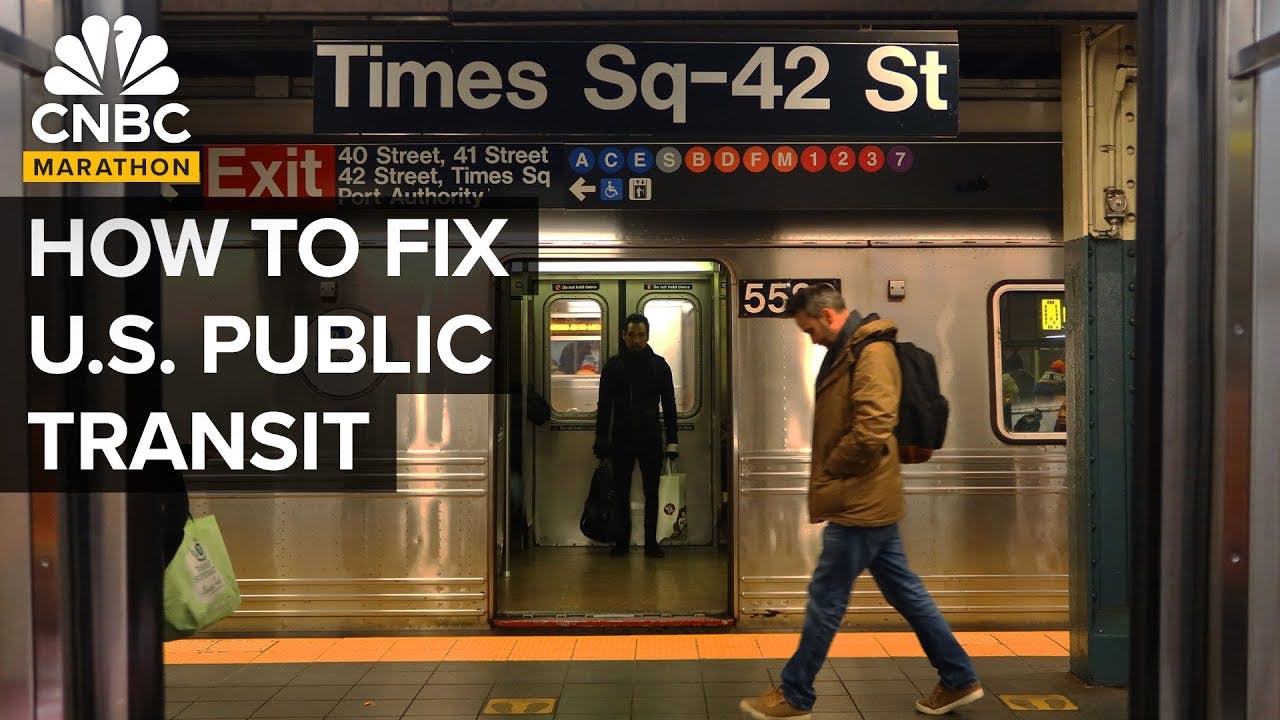How To Fix Public Transit In The U.S. | CNBC Marathon
()

Introduction (00:00:00)
- The U.S. government has historically prioritized cars over public transportation, investing significantly more in road infrastructure than transit.
- Violent crime in New York City's subway system has reached new highs, deterring some people from using public transit.
- The number of public transit commuters has significantly decreased since before the pandemic.
- Autonomous rapid transit (ART) is presented as a potential alternative that could be faster than buses but more affordable and less complex than subways.
Why The U.S. Gave Up On Public Transit (Published July 2023) (00:00:39)
- The U.S. public transit system is inadequate, with long wait times, infrequent service, and limited accessibility, leaving nearly half of Americans without access to reliable public transportation.
- Despite significant funding ($79 billion in 2019), public transit faces a fiscal crisis with a $176 billion backlog in infrastructure updates, potentially leading to fare increases and service reductions.
- The decline of streetcars, once a robust public transit system, was caused by rising operating costs and the inability to raise fares, leading to bankruptcy and the shift towards car-centric cities.
- Public transit funding in the U.S. is inadequate compared to highway funding, leading to disparities in transportation infrastructure.
- Public transit is heavily subsidized due to low revenue from rider fares, making it difficult to cover operating costs.
- Insufficient funding for public transit in the US hinders its operations and capital improvements.
- A thriving public transit system benefits the local economy, with 87% of transit trips directly benefiting it, and every dollar invested generating $5 in economic returns.
- Public transit provides employment opportunities for people who cannot afford cars, improving their access to healthcare, social connections, and economic stability.
- Redesigning cities with denser neighborhoods and zoning changes around transit hubs can enhance public transit effectiveness.
- Public transportation serves as a vital public space where people from diverse backgrounds can interact and encounter each other, fostering social cohesion.
Why The NYC Subway Is Such A Mess (Published September 2023) (00:13:10)
- The average weekday ridership on the New York City subway has decreased by 34% since 2019 due to remote work and safety concerns, resulting in a loss of revenue for the MTA.
- Fare evasion, costing the MTA $690 million in 2022, is a significant issue, with various methods used to avoid paying fares.
- The MTA is considering replacing turnstiles with advanced technology, such as 3D faregates, to deter fare evasion.
- The New York City subway system began in 1904 with private companies operating different lines, but in 1940, the three competing subway systems were consolidated into one of the largest transit systems in the world.
- The MTA faces financial challenges, with a significant portion of its budget allocated to debt repayment rather than operations and capital improvements, requiring constant requests for state and federal assistance.
- The shift towards remote work and hybrid policies may prolong the recovery of fare revenue and subway ridership to pre-pandemic levels.
- Long-term goals for the transit system include restoring ridership to pre-pandemic levels, reducing commuter rail costs, and enhancing safety.
How An Autonomous Train-Bus Hybrid Could Transform City Transit (Published February 2023) (00:27:34)
- The U.S. public transit system lags behind other countries, with only 2% of Americans using mass rapid transit and 2.3% using buses, mainly due to poor ride quality.
- Autonomous Rapid Transit (ART) is a mid-tier transportation system that combines features of trains and buses, offering a smoother ride with electric power, rubber wheels, and stabilizing technology.
- ART has been deployed in several cities in China and Israel and is being considered worldwide to connect larger train or metro systems.
- Trackless trams are a cost-effective alternative to traditional trams, costing around one-fifth the price per mile and allowing for easier route changes.
- New York City's outdated metro system lacks connectivity to popular neighborhoods, and the proposed BQX light rail project faces challenges due to its high cost and disruption.
- Trackless trams offer a more cost-effective solution for the BQX route, potentially costing one-tenth to one-third of the estimated cost of a streetcar, but require political courage to allocate dedicated right-of-way space.
- Prioritizing public transportation infrastructure and implementing successful technologies like ART and trackless trams could benefit growing American cities.